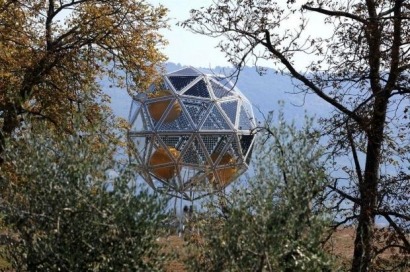
The Diamond is the latest generation photovoltaic power plant designed and developed by Enel’s Research Department in partnership with the University of Pisa. Enel reveals that the cutting-edge system will allow tests to be conducted for the first time ever into storing power generated by photovoltaic panels in a storage system so that the electricity can be supplied even when skies are overcast.
The Municipality of Rome, which signed up to the EU Covenant of Mayors to cut greenhouse gas emissions by over 20% by 2020 in participating European cities, turned to Enel to find the best location for the Diamond in the Italian capital: a city that is home to a treasure trove of monuments from the past as well architectural designs of the modern and contemporary era.
“Seen in this light, the Diamond is fully in tune with the city’s vocation, taking on an even greater significance as the symbol of the city’s commitment to combating atmospheric pollution and reducing carbon dioxide emissions,” explains Enel. “[It] will act as a bridge between the modern and contemporary architectural styles, representing innovative research applied to architecture both from the visual and functional points of view.”
The Diamond’s architectural structure, shaped like a Fuller geodesic dome built from glass and steel, is particularly suited for being placed in prestigious architectural locations and environmental contexts such as that of Valle Giulia, where the Faculty of Architecture intends to upgrade a currently unused green space near the National Gallery of Modern and Contemporary Art, opposite the Villa Borghese Park. The area will be lit thanks to the zero-emission power generated by the Diamond.
The Diamond is composed of a sphere, with an 8-metre diameter. Thirty-eight polycrystalline silicon solar panels are arranged on the crown and the south-facing side. The remaining surface is covered with glass panels to protect the structure against the wind. Its output will be used to recharge electric bicycles and electric cars, to provide street lighting, etc.
Three spheres, each 2 metres in diameter, inside the Diamond, comprise hydrogen storage tanks, which act as batteries to provide power during the night or when the sunlight is not strong enough to bring the solar panels online. Enel says the batteries will provide a continuous supply of electricity “sufficient to guarantee the energy self-sufficiency of a small apartment block.
Given the high-tech profile of the Diamond, Enel, the Municipality of Rome and the University of Rome intend to work together on research initiatives and projects aimed at fostering an environmentally-friendly energy culture which is also integrated within its urban surroundings, with Enel describing the system as "a test bed for the latest developments in solar power technology".
For additional information:

